Case Study 3: Copyright and Intellectual Property
VerifiedAdded on 2020/02/24
|7
|1106
|357
Case Study
AI Summary
This case study examines the ethical dilemma faced by Courtney, a software developer, who created an application for Aboriginal communities but was not recognized for her work. It discusses the implications of the ACS codes of ethics and professionalism, the consequences of actions taken, and the importance of public interest in the ICT field. The study utilizes the Thomas White Methodology to propose solutions for ensuring Courtney receives the recognition she deserves.

Case Study 3: Copyright And Intellectual Property Considerations
Name
Date
Name
Date
Paraphrase This Document
Need a fresh take? Get an instant paraphrase of this document with our AI Paraphraser
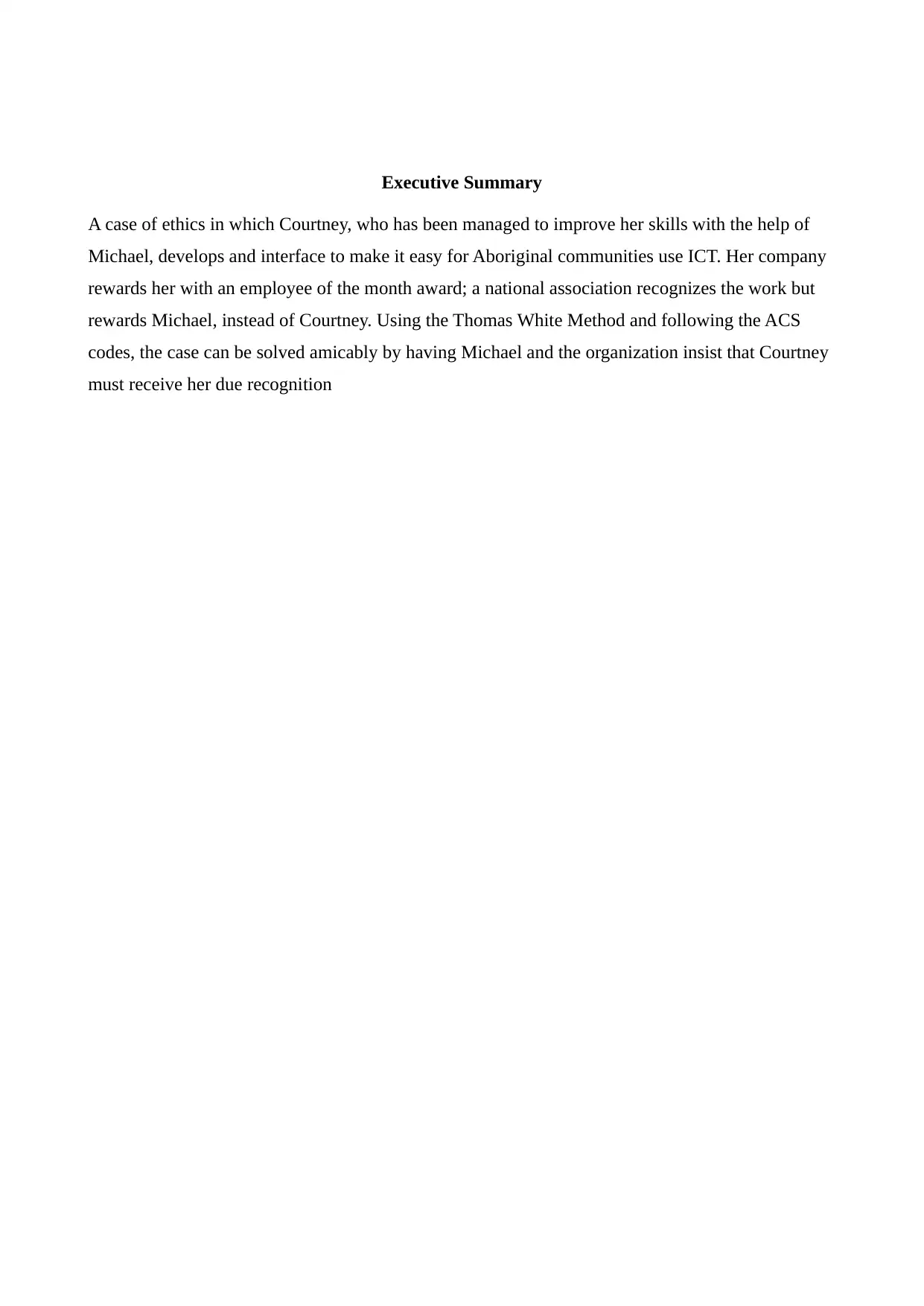
Executive Summary
A case of ethics in which Courtney, who has been managed to improve her skills with the help of
Michael, develops and interface to make it easy for Aboriginal communities use ICT. Her company
rewards her with an employee of the month award; a national association recognizes the work but
rewards Michael, instead of Courtney. Using the Thomas White Method and following the ACS
codes, the case can be solved amicably by having Michael and the organization insist that Courtney
must receive her due recognition
A case of ethics in which Courtney, who has been managed to improve her skills with the help of
Michael, develops and interface to make it easy for Aboriginal communities use ICT. Her company
rewards her with an employee of the month award; a national association recognizes the work but
rewards Michael, instead of Courtney. Using the Thomas White Method and following the ACS
codes, the case can be solved amicably by having Michael and the organization insist that Courtney
must receive her due recognition
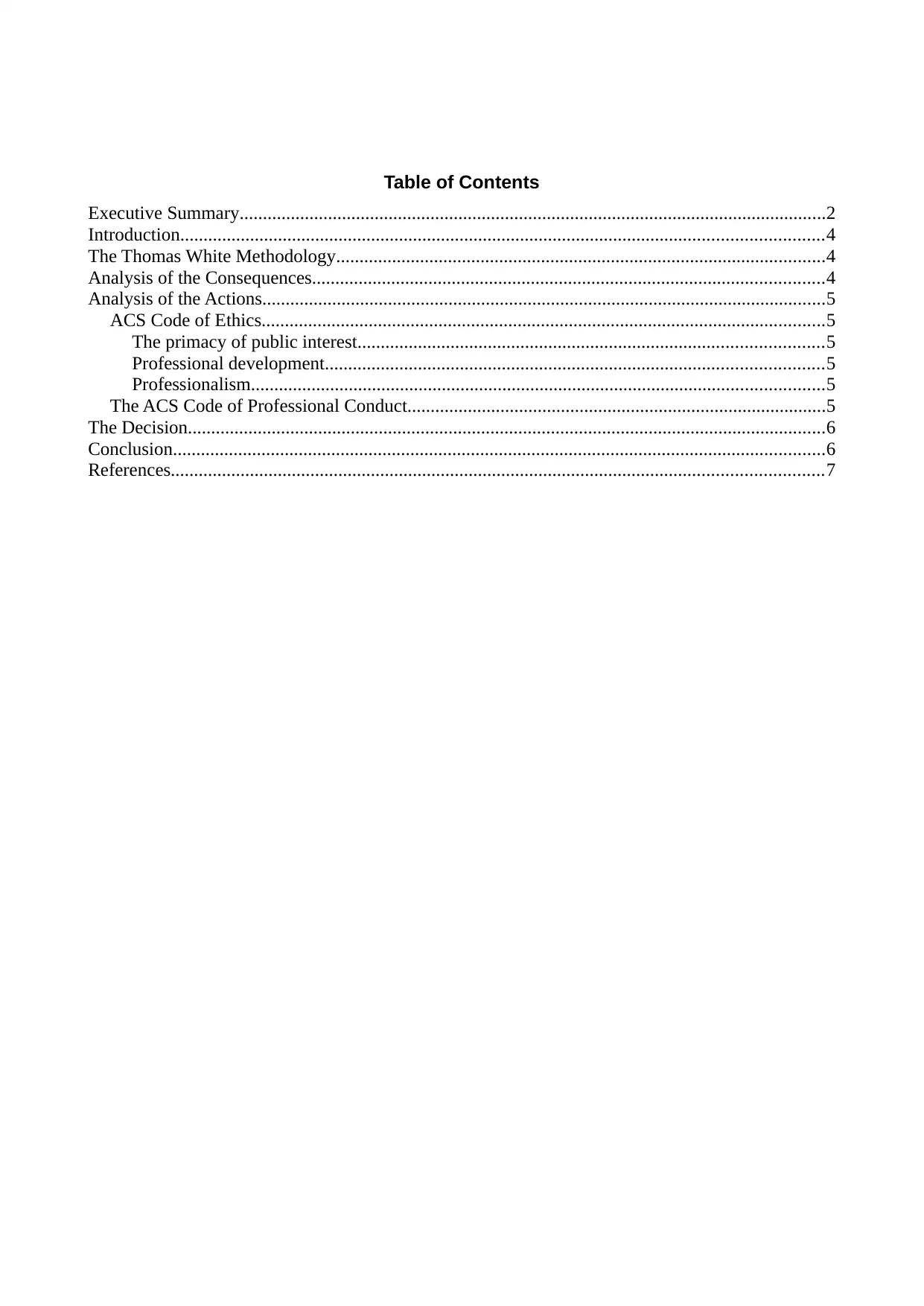
Table of Contents
Executive Summary..............................................................................................................................2
Introduction..........................................................................................................................................4
The Thomas White Methodology.........................................................................................................4
Analysis of the Consequences..............................................................................................................4
Analysis of the Actions.........................................................................................................................5
ACS Code of Ethics.........................................................................................................................5
The primacy of public interest....................................................................................................5
Professional development...........................................................................................................5
Professionalism...........................................................................................................................5
The ACS Code of Professional Conduct..........................................................................................5
The Decision.........................................................................................................................................6
Conclusion............................................................................................................................................6
References............................................................................................................................................7
Executive Summary..............................................................................................................................2
Introduction..........................................................................................................................................4
The Thomas White Methodology.........................................................................................................4
Analysis of the Consequences..............................................................................................................4
Analysis of the Actions.........................................................................................................................5
ACS Code of Ethics.........................................................................................................................5
The primacy of public interest....................................................................................................5
Professional development...........................................................................................................5
Professionalism...........................................................................................................................5
The ACS Code of Professional Conduct..........................................................................................5
The Decision.........................................................................................................................................6
Conclusion............................................................................................................................................6
References............................................................................................................................................7
⊘ This is a preview!⊘
Do you want full access?
Subscribe today to unlock all pages.

Trusted by 1+ million students worldwide
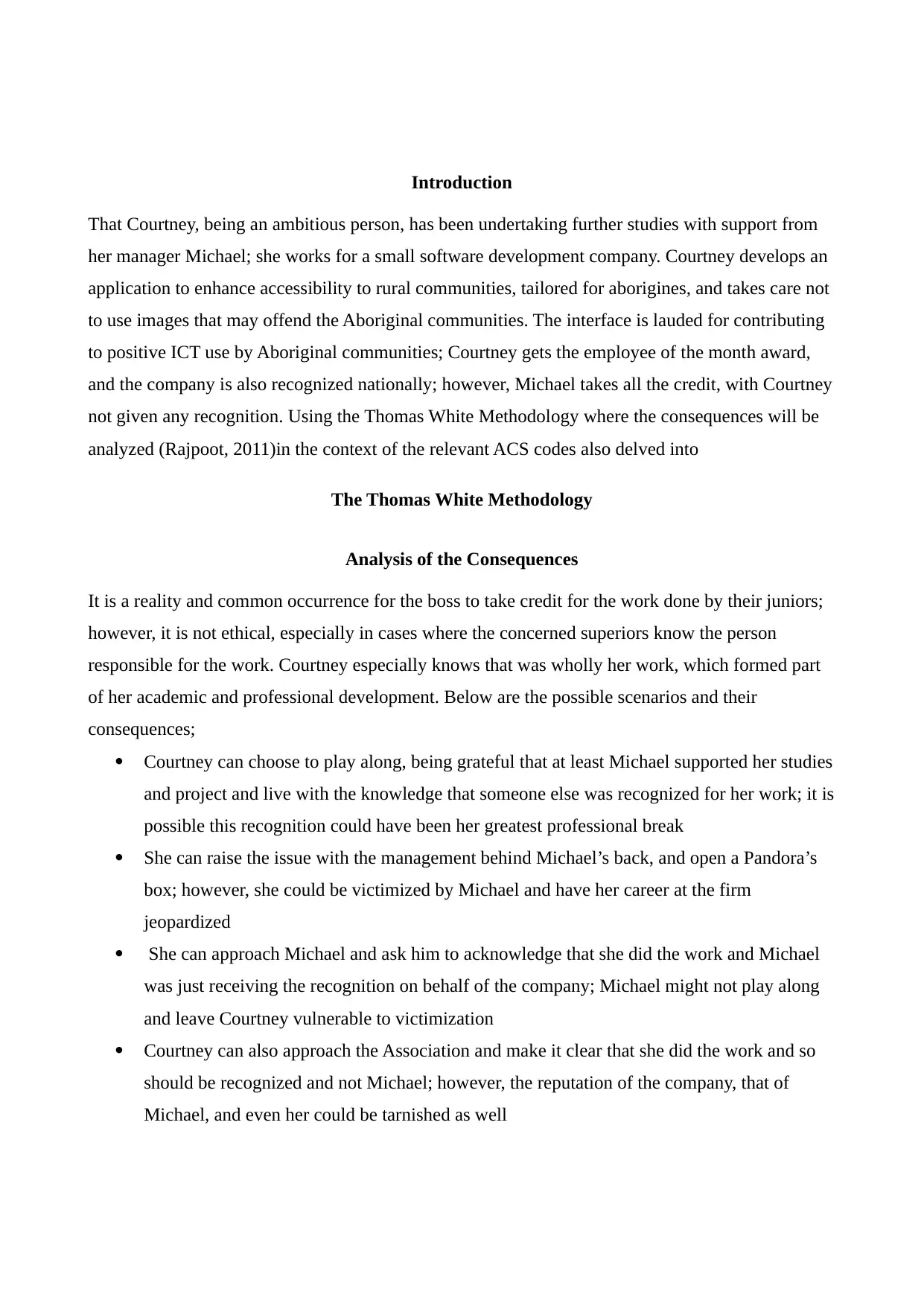
Introduction
That Courtney, being an ambitious person, has been undertaking further studies with support from
her manager Michael; she works for a small software development company. Courtney develops an
application to enhance accessibility to rural communities, tailored for aborigines, and takes care not
to use images that may offend the Aboriginal communities. The interface is lauded for contributing
to positive ICT use by Aboriginal communities; Courtney gets the employee of the month award,
and the company is also recognized nationally; however, Michael takes all the credit, with Courtney
not given any recognition. Using the Thomas White Methodology where the consequences will be
analyzed (Rajpoot, 2011)in the context of the relevant ACS codes also delved into
The Thomas White Methodology
Analysis of the Consequences
It is a reality and common occurrence for the boss to take credit for the work done by their juniors;
however, it is not ethical, especially in cases where the concerned superiors know the person
responsible for the work. Courtney especially knows that was wholly her work, which formed part
of her academic and professional development. Below are the possible scenarios and their
consequences;
Courtney can choose to play along, being grateful that at least Michael supported her studies
and project and live with the knowledge that someone else was recognized for her work; it is
possible this recognition could have been her greatest professional break
She can raise the issue with the management behind Michael’s back, and open a Pandora’s
box; however, she could be victimized by Michael and have her career at the firm
jeopardized
She can approach Michael and ask him to acknowledge that she did the work and Michael
was just receiving the recognition on behalf of the company; Michael might not play along
and leave Courtney vulnerable to victimization
Courtney can also approach the Association and make it clear that she did the work and so
should be recognized and not Michael; however, the reputation of the company, that of
Michael, and even her could be tarnished as well
That Courtney, being an ambitious person, has been undertaking further studies with support from
her manager Michael; she works for a small software development company. Courtney develops an
application to enhance accessibility to rural communities, tailored for aborigines, and takes care not
to use images that may offend the Aboriginal communities. The interface is lauded for contributing
to positive ICT use by Aboriginal communities; Courtney gets the employee of the month award,
and the company is also recognized nationally; however, Michael takes all the credit, with Courtney
not given any recognition. Using the Thomas White Methodology where the consequences will be
analyzed (Rajpoot, 2011)in the context of the relevant ACS codes also delved into
The Thomas White Methodology
Analysis of the Consequences
It is a reality and common occurrence for the boss to take credit for the work done by their juniors;
however, it is not ethical, especially in cases where the concerned superiors know the person
responsible for the work. Courtney especially knows that was wholly her work, which formed part
of her academic and professional development. Below are the possible scenarios and their
consequences;
Courtney can choose to play along, being grateful that at least Michael supported her studies
and project and live with the knowledge that someone else was recognized for her work; it is
possible this recognition could have been her greatest professional break
She can raise the issue with the management behind Michael’s back, and open a Pandora’s
box; however, she could be victimized by Michael and have her career at the firm
jeopardized
She can approach Michael and ask him to acknowledge that she did the work and Michael
was just receiving the recognition on behalf of the company; Michael might not play along
and leave Courtney vulnerable to victimization
Courtney can also approach the Association and make it clear that she did the work and so
should be recognized and not Michael; however, the reputation of the company, that of
Michael, and even her could be tarnished as well
Paraphrase This Document
Need a fresh take? Get an instant paraphrase of this document with our AI Paraphraser
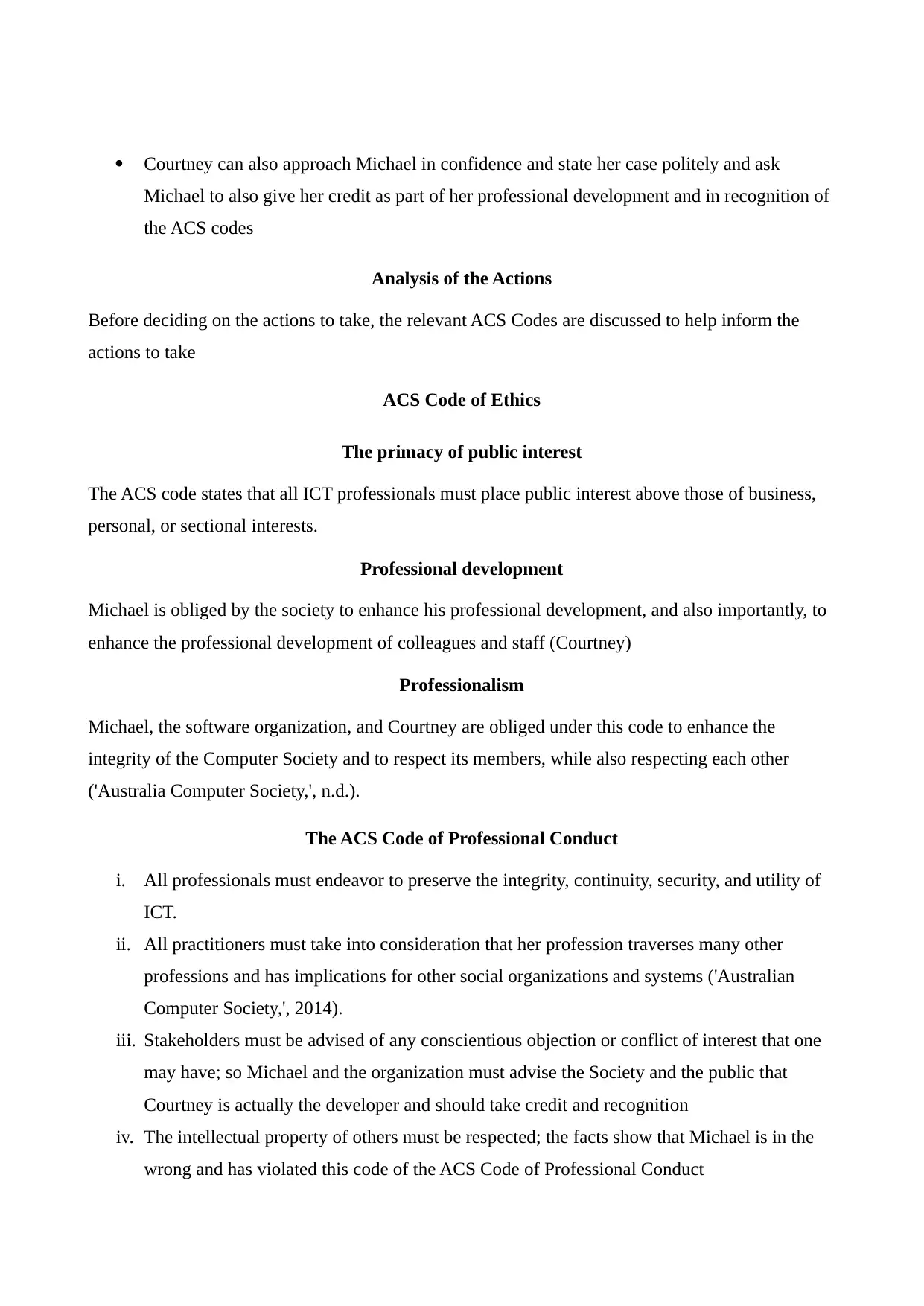
Courtney can also approach Michael in confidence and state her case politely and ask
Michael to also give her credit as part of her professional development and in recognition of
the ACS codes
Analysis of the Actions
Before deciding on the actions to take, the relevant ACS Codes are discussed to help inform the
actions to take
ACS Code of Ethics
The primacy of public interest
The ACS code states that all ICT professionals must place public interest above those of business,
personal, or sectional interests.
Professional development
Michael is obliged by the society to enhance his professional development, and also importantly, to
enhance the professional development of colleagues and staff (Courtney)
Professionalism
Michael, the software organization, and Courtney are obliged under this code to enhance the
integrity of the Computer Society and to respect its members, while also respecting each other
('Australia Computer Society,', n.d.).
The ACS Code of Professional Conduct
i. All professionals must endeavor to preserve the integrity, continuity, security, and utility of
ICT.
ii. All practitioners must take into consideration that her profession traverses many other
professions and has implications for other social organizations and systems ('Australian
Computer Society,', 2014).
iii. Stakeholders must be advised of any conscientious objection or conflict of interest that one
may have; so Michael and the organization must advise the Society and the public that
Courtney is actually the developer and should take credit and recognition
iv. The intellectual property of others must be respected; the facts show that Michael is in the
wrong and has violated this code of the ACS Code of Professional Conduct
Michael to also give her credit as part of her professional development and in recognition of
the ACS codes
Analysis of the Actions
Before deciding on the actions to take, the relevant ACS Codes are discussed to help inform the
actions to take
ACS Code of Ethics
The primacy of public interest
The ACS code states that all ICT professionals must place public interest above those of business,
personal, or sectional interests.
Professional development
Michael is obliged by the society to enhance his professional development, and also importantly, to
enhance the professional development of colleagues and staff (Courtney)
Professionalism
Michael, the software organization, and Courtney are obliged under this code to enhance the
integrity of the Computer Society and to respect its members, while also respecting each other
('Australia Computer Society,', n.d.).
The ACS Code of Professional Conduct
i. All professionals must endeavor to preserve the integrity, continuity, security, and utility of
ICT.
ii. All practitioners must take into consideration that her profession traverses many other
professions and has implications for other social organizations and systems ('Australian
Computer Society,', 2014).
iii. Stakeholders must be advised of any conscientious objection or conflict of interest that one
may have; so Michael and the organization must advise the Society and the public that
Courtney is actually the developer and should take credit and recognition
iv. The intellectual property of others must be respected; the facts show that Michael is in the
wrong and has violated this code of the ACS Code of Professional Conduct
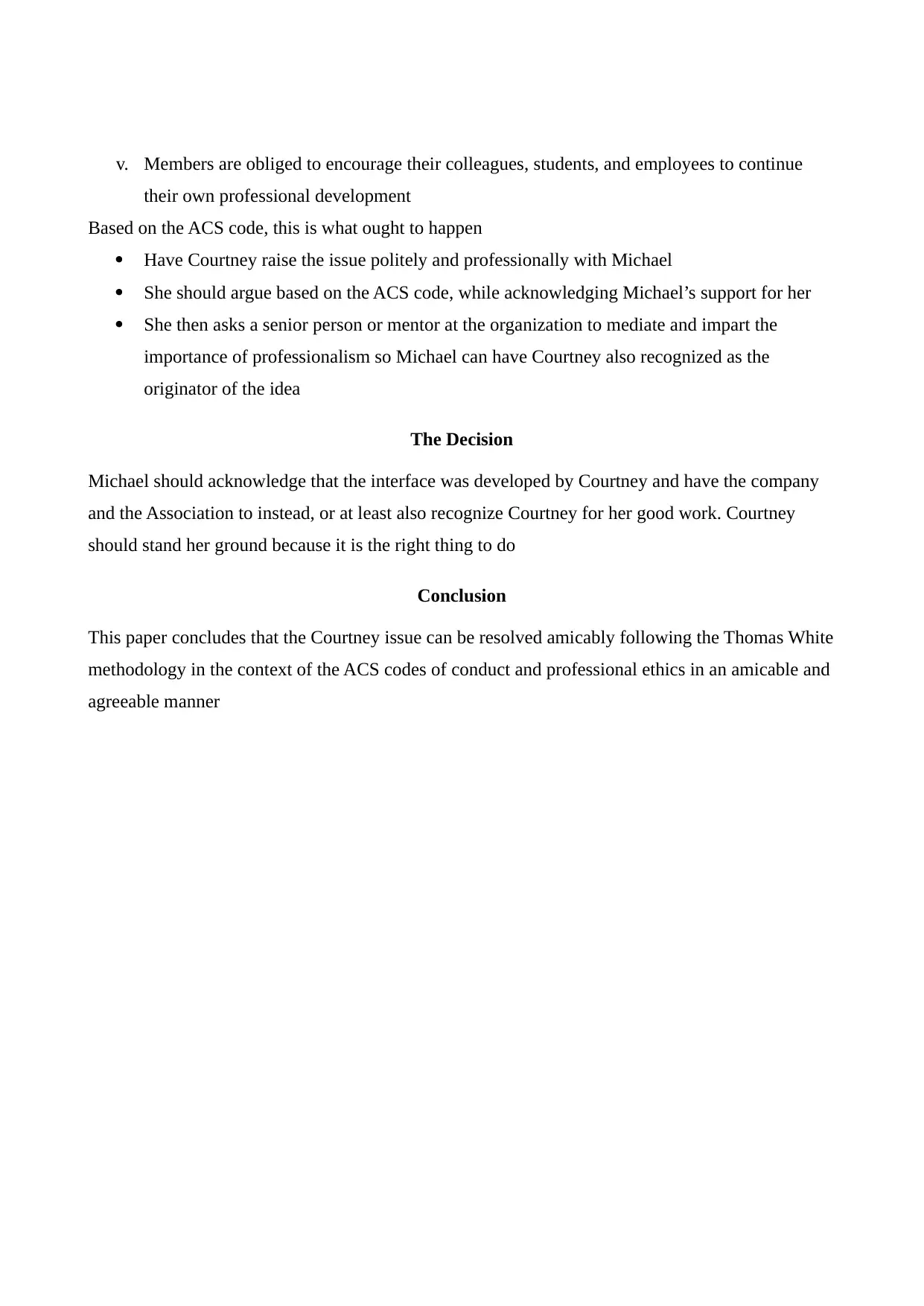
v. Members are obliged to encourage their colleagues, students, and employees to continue
their own professional development
Based on the ACS code, this is what ought to happen
Have Courtney raise the issue politely and professionally with Michael
She should argue based on the ACS code, while acknowledging Michael’s support for her
She then asks a senior person or mentor at the organization to mediate and impart the
importance of professionalism so Michael can have Courtney also recognized as the
originator of the idea
The Decision
Michael should acknowledge that the interface was developed by Courtney and have the company
and the Association to instead, or at least also recognize Courtney for her good work. Courtney
should stand her ground because it is the right thing to do
Conclusion
This paper concludes that the Courtney issue can be resolved amicably following the Thomas White
methodology in the context of the ACS codes of conduct and professional ethics in an amicable and
agreeable manner
their own professional development
Based on the ACS code, this is what ought to happen
Have Courtney raise the issue politely and professionally with Michael
She should argue based on the ACS code, while acknowledging Michael’s support for her
She then asks a senior person or mentor at the organization to mediate and impart the
importance of professionalism so Michael can have Courtney also recognized as the
originator of the idea
The Decision
Michael should acknowledge that the interface was developed by Courtney and have the company
and the Association to instead, or at least also recognize Courtney for her good work. Courtney
should stand her ground because it is the right thing to do
Conclusion
This paper concludes that the Courtney issue can be resolved amicably following the Thomas White
methodology in the context of the ACS codes of conduct and professional ethics in an amicable and
agreeable manner
⊘ This is a preview!⊘
Do you want full access?
Subscribe today to unlock all pages.

Trusted by 1+ million students worldwide
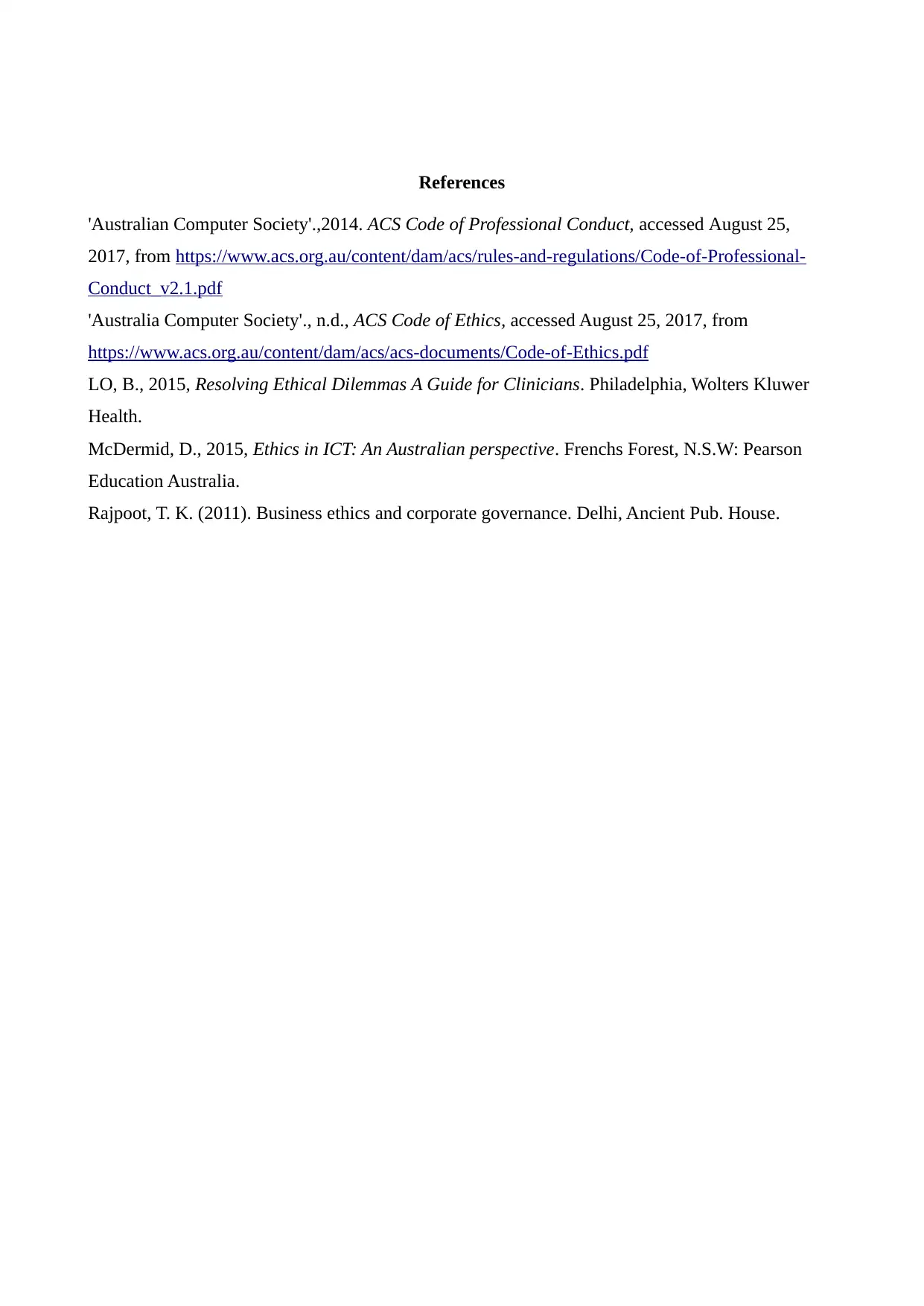
References
'Australian Computer Society'.,2014. ACS Code of Professional Conduct, accessed August 25,
2017, from https://www.acs.org.au/content/dam/acs/rules-and-regulations/Code-of-Professional-
Conduct_v2.1.pdf
'Australia Computer Society'., n.d., ACS Code of Ethics, accessed August 25, 2017, from
https://www.acs.org.au/content/dam/acs/acs-documents/Code-of-Ethics.pdf
LO, B., 2015, Resolving Ethical Dilemmas A Guide for Clinicians. Philadelphia, Wolters Kluwer
Health.
McDermid, D., 2015, Ethics in ICT: An Australian perspective. Frenchs Forest, N.S.W: Pearson
Education Australia.
Rajpoot, T. K. (2011). Business ethics and corporate governance. Delhi, Ancient Pub. House.
'Australian Computer Society'.,2014. ACS Code of Professional Conduct, accessed August 25,
2017, from https://www.acs.org.au/content/dam/acs/rules-and-regulations/Code-of-Professional-
Conduct_v2.1.pdf
'Australia Computer Society'., n.d., ACS Code of Ethics, accessed August 25, 2017, from
https://www.acs.org.au/content/dam/acs/acs-documents/Code-of-Ethics.pdf
LO, B., 2015, Resolving Ethical Dilemmas A Guide for Clinicians. Philadelphia, Wolters Kluwer
Health.
McDermid, D., 2015, Ethics in ICT: An Australian perspective. Frenchs Forest, N.S.W: Pearson
Education Australia.
Rajpoot, T. K. (2011). Business ethics and corporate governance. Delhi, Ancient Pub. House.
1 out of 7
Related Documents
Your All-in-One AI-Powered Toolkit for Academic Success.
+13062052269
info@desklib.com
Available 24*7 on WhatsApp / Email
![[object Object]](/_next/static/media/star-bottom.7253800d.svg)
Unlock your academic potential
Copyright © 2020–2025 A2Z Services. All Rights Reserved. Developed and managed by ZUCOL.





